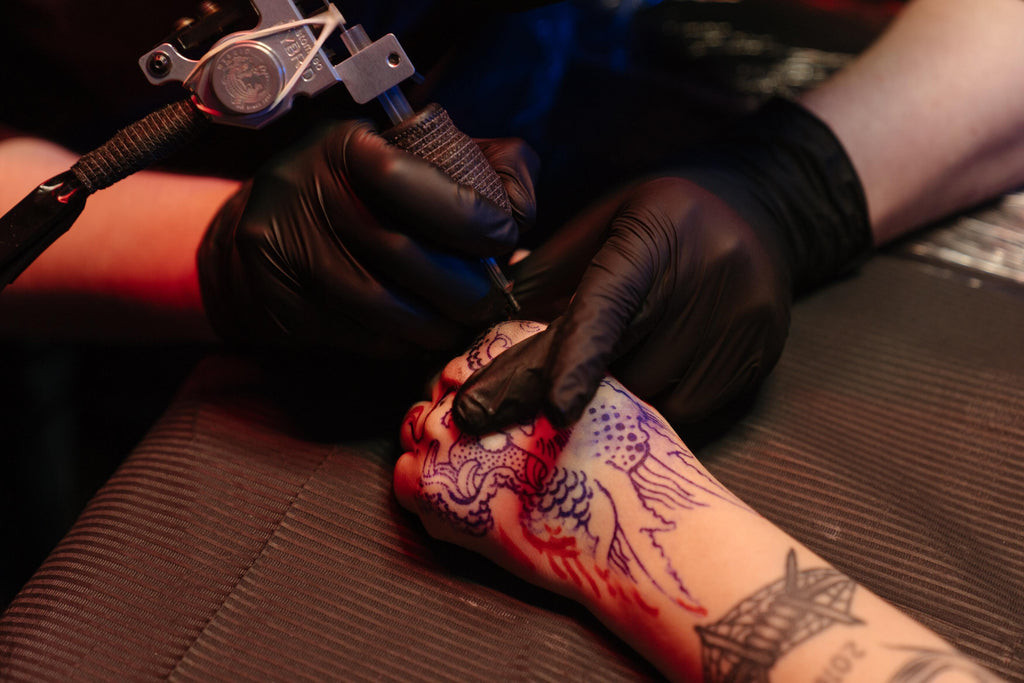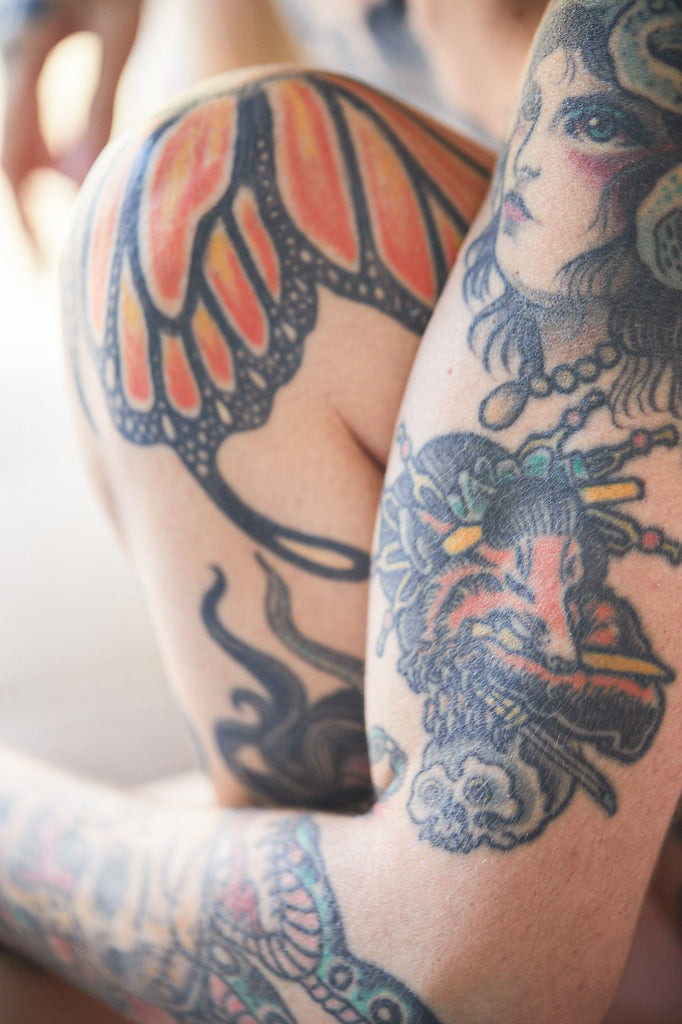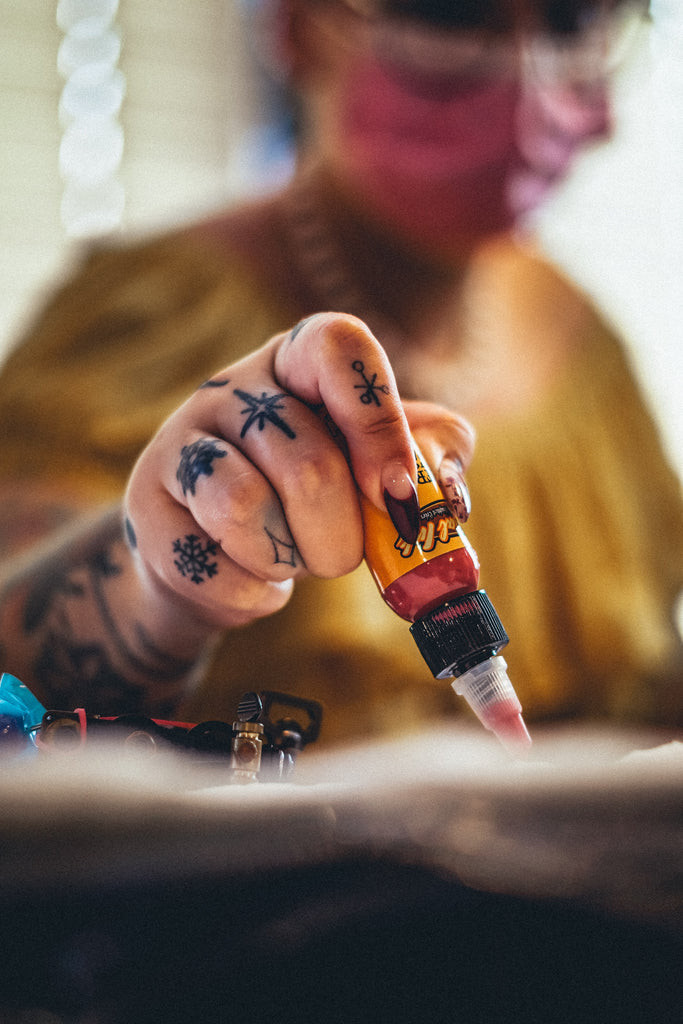Tattoos are a fantastic way to express yourself through unique body art, but have you ever noticed your tattoos feeling raised? Understanding why your tattoos raise is essential for proper tattoo aftercare and maintenance, and tattooat.com is here to guide you. Let’s explore the common causes of this phenomenon, from fresh ink to potential allergic reactions, and discover how to keep your skin art looking and feeling its best. Explore the world of skin art and find solutions for tattoo elevation, ink swelling, and allergic reactions with expert advice.
1. Why Do New Tattoos Feel Raised?
Yes, new tattoos often feel raised due to the body’s natural healing process. When you get a tattoo, the needles puncture your skin, creating tiny wounds. This triggers an inflammatory response, causing the area around the tattoo to swell and the lines to feel elevated. This is perfectly normal and usually subsides as the tattoo heals.
1.1. The Healing Process Explained
Think of a tattoo as a controlled injury. Your body rushes to repair the damaged tissue, leading to inflammation. This inflammation manifests as swelling and a raised feeling around the inked area. The intensity of the raised feeling can vary depending on factors like:
- Tattoo size and complexity: Larger, more intricate tattoos involve more trauma to the skin, potentially leading to more pronounced swelling.
- Location: Areas with thinner skin, like the ribs or ankles, may be more sensitive and prone to swelling.
- Individual healing rates: Everyone’s body heals at its own pace. Some people may experience minimal swelling, while others might have more noticeable elevation.
1.2. How Long Will the Raised Feeling Last?
Typically, the raised feeling associated with a new tattoo diminishes within a few weeks to a month as the initial inflammation subsides. During this time, proper aftercare is crucial to promote healing and minimize any discomfort. Keep the tattoo clean, moisturized, and protected from the sun.
1.3. What If My New Tattoo Doesn’t Stop Feeling Raised?
If the raised feeling persists beyond a month or is accompanied by other symptoms like excessive redness, pain, pus, or fever, it’s essential to consult a healthcare professional. These could be signs of an infection or other complications that require medical attention.
 New tattoo on forearm with redness
New tattoo on forearm with redness
Alt text: A close-up of a freshly done forearm tattoo showing some redness and slight swelling, indicating the initial healing phase.
2. Why Do Old Tattoos Feel Raised Sometimes?
Yes, old tattoos can sometimes feel raised due to various factors such as scar tissue formation, changes in weather conditions, or even allergic reactions. Understanding these causes can help you manage the issue effectively.
2.1. Scar Tissue: A Common Culprit
Even after a tattoo has fully healed, some degree of scar tissue can form beneath the skin. This scar tissue is typically subtle and unnoticeable, but certain factors can cause it to become more prominent and lead to a raised feeling:
- Aggressive Tattooing: If the tattoo artist used excessive pressure or a heavy hand during the tattooing process, it can lead to more significant trauma to the skin and increased scar tissue formation.
- Location: Areas prone to rubbing or friction, like the elbows or knees, may develop more scar tissue over time.
- Individual Predisposition: Some people are simply more prone to developing scar tissue than others.
2.2. Weather Conditions: The Impact of Temperature and Humidity
Changes in weather can also affect the way your old tattoo feels. Warmer temperatures and high humidity can cause the skin to swell slightly, making the tattoo lines feel more raised. Conversely, cold, dry weather can cause the skin to contract, which can also accentuate the scar tissue and make the tattoo feel elevated.
2.3. Allergies: A Late Reaction?
Though less common, allergic reactions to tattoo ink can occur even years after getting the tattoo. These reactions can cause inflammation and swelling, leading to a raised feeling. Allergic reactions are more likely to be associated with certain ink colors, particularly red.
2.4. Other Potential Causes
Other factors that can contribute to a raised feeling in old tattoos include:
- Skin conditions: Eczema, psoriasis, or other skin conditions can affect the tattooed area and cause inflammation and elevation.
- Sun exposure: Sunburn can damage the skin and exacerbate any existing scar tissue, leading to a raised feeling.
 Arm tattoo with fine lines
Arm tattoo with fine lines
Alt text: A close-up of an arm tattoo featuring fine lines, showcasing the intricate detail and potential for scar tissue formation over time.
3. What Are the Symptoms of a Raised Tattoo?
The primary symptom of a raised tattoo is a noticeable elevation of the tattooed area compared to the surrounding skin. However, other symptoms may accompany this elevation, depending on the underlying cause.
3.1. Common Symptoms to Watch Out For
- Itching: Itching is a common symptom, especially if the raised feeling is due to an allergic reaction or skin irritation.
- Redness: The tattooed area may appear red or inflamed, indicating irritation or infection.
- Swelling: Swelling is another common symptom, particularly in new tattoos or in cases of allergic reactions.
- Pain or Tenderness: The area may be painful to the touch, especially if there is an infection or significant inflammation.
- Bumps or Blisters: Small bumps or blisters may appear on or around the tattoo, which could be a sign of an allergic reaction or infection.
- Dryness or Flaking: The skin around the tattoo may become dry and flaky, particularly in cold weather or if the area is not properly moisturized.
3.2. When to Seek Professional Advice
While a mild raised feeling with minimal symptoms is often harmless, it’s important to seek professional advice if you experience any of the following:
- Severe pain or tenderness
- Excessive redness or swelling
- Pus or drainage from the tattooed area
- Fever or chills
- Spreading rash or hives
- Difficulty breathing or swallowing
These symptoms could indicate a serious infection or allergic reaction that requires immediate medical attention.
4. Can Tattoo Ink Cause Allergic Reactions?
Yes, tattoo ink can indeed cause allergic reactions in some individuals. While allergic reactions to tattoo ink are relatively rare, they can occur with both new and old tattoos.
4.1. Common Allergens in Tattoo Ink
Tattoo inks contain a variety of pigments and chemicals that can potentially trigger allergic reactions. Some of the most common allergens found in tattoo ink include:
- Mercury sulfide (red ink)
- Cadmium sulfide (yellow ink)
- Chromium oxide (green ink)
- Cobalt chloride (blue ink)
- Manganese (purple ink)
4.2. Types of Allergic Reactions to Tattoo Ink
Allergic reactions to tattoo ink can manifest in different ways, ranging from mild skin irritations to more severe systemic reactions. Some common types of allergic reactions include:
- Contact Dermatitis: This is the most common type of allergic reaction, characterized by itching, redness, swelling, and blistering at the site of the tattoo.
- Photoallergic Reactions: These reactions occur when the tattoo is exposed to sunlight, causing itching, redness, and blistering.
- Granulomas: Granulomas are small, raised bumps that can form around the tattoo, caused by an inflammatory response to the ink.
- Lichenoid Reactions: These reactions are characterized by small, flat-topped bumps that resemble lichen planus.
- Systemic Reactions: In rare cases, allergic reactions to tattoo ink can cause more severe systemic symptoms such as fever, chills, and difficulty breathing.
4.3. Diagnosis and Treatment of Allergic Reactions
If you suspect you’re having an allergic reaction to your tattoo ink, it’s important to consult a healthcare professional for diagnosis and treatment. They may perform a skin patch test to identify the specific allergen causing the reaction. Treatment options may include:
- Topical corticosteroids: To reduce inflammation and itching
- Oral antihistamines: To relieve itching and other allergy symptoms
- Oral corticosteroids: For more severe reactions
- Laser tattoo removal: In extreme cases, tattoo removal may be necessary to eliminate the allergen completely.
 Woman's arm tattoo
Woman's arm tattoo
Alt text: A woman displaying her colorful arm tattoo, highlighting the potential for allergic reactions due to the diverse range of ink pigments used.
5. How Do I Treat a Raised Tattoo at Home?
For mild cases of raised tattoos, several home remedies can provide relief and promote healing.
5.1. Home Remedies for Relief
- Cold Compress: Applying a cold compress to the tattooed area can help reduce swelling and inflammation. Wrap a bag of ice or frozen vegetables in a towel and apply it to the tattoo for 15-20 minutes at a time.
- Moisturizing: Keeping the skin moisturized can prevent dryness and flaking, which can exacerbate the raised feeling. Use a fragrance-free, hypoallergenic lotion or ointment.
- Oatmeal Bath: Soaking in an oatmeal bath can help soothe itchy, irritated skin. Add colloidal oatmeal to a lukewarm bath and soak for 15-20 minutes.
- Aloe Vera: Applying aloe vera gel to the tattooed area can help reduce inflammation and promote healing.
- Elevation: If the tattoo is on an extremity, elevating it can help reduce swelling.
5.2. Products to Use and Avoid
- Use:
- Fragrance-free, hypoallergenic lotions and ointments
- Colloidal oatmeal
- Aloe vera gel
- Mild, unscented soap
- Avoid:
- Harsh soaps and detergents
- Fragrances and dyes
- Alcohol-based products
- Scratching or picking at the tattoo
5.3. When to See a Doctor
If your symptoms don’t improve with home remedies or if you experience any signs of infection or allergic reaction, it’s important to see a doctor.
6. How Can I Prevent My Tattoos From Raising?
While it’s not always possible to completely prevent tattoos from raising, there are several steps you can take to minimize the risk and keep your skin art looking its best.
6.1. Choosing the Right Tattoo Artist and Studio
- Research: Before getting a tattoo, research different artists and studios in your area. Look for artists with experience, a good reputation, and a portfolio of high-quality work.
- Hygiene: Make sure the studio is clean and sterile, and that the artist uses disposable needles and gloves.
- Consultation: Schedule a consultation with the artist to discuss your design, placement, and any concerns you may have.
6.2. Proper Tattoo Aftercare
- Follow Instructions: Follow your tattoo artist’s aftercare instructions carefully. This typically includes keeping the tattoo clean, moisturized, and protected from the sun.
- Avoid Irritants: Avoid using harsh soaps, fragrances, and other irritants on the tattooed area.
- Don’t Pick or Scratch: Resist the urge to pick or scratch at the tattoo, as this can damage the skin and increase the risk of infection.
6.3. Lifestyle Factors
- Stay Hydrated: Drinking plenty of water can help keep your skin hydrated and healthy.
- Protect From the Sun: Sun exposure can damage the skin and exacerbate scar tissue formation. Apply sunscreen to your tattoo whenever you’re outdoors.
- Avoid Trauma: Avoid activities that could traumatize the tattooed area, such as excessive rubbing or friction.
7. Understanding Tattoo Healing Stages
Knowing what to expect during each stage of the tattoo healing process can help you identify potential problems early on and take appropriate action.
7.1. The Initial Stage (Days 1-7)
- Symptoms: Redness, swelling, pain, oozing of plasma and ink.
- Care: Keep the tattoo clean and dry, apply a thin layer of ointment as directed by your artist.
7.2. The Itchy Stage (Days 7-14)
- Symptoms: Itching, flaking, scabbing.
- Care: Continue to keep the tattoo clean and moisturized. Avoid scratching or picking at the scabs.
7.3. The Settling Stage (Weeks 3-4)
- Symptoms: The tattoo may appear dull or faded as the skin regenerates.
- Care: Continue to moisturize the tattoo and protect it from the sun.
7.4. The Long-Term Stage (Months 1+)
- Symptoms: The tattoo should be fully healed and vibrant.
- Care: Continue to protect the tattoo from the sun and keep it moisturized to maintain its appearance.
8. Tattoo Styles and Their Impact on Skin
Different tattoo styles can have varying impacts on the skin. Understanding these differences can help you choose a style that’s less likely to cause problems like raised tattoos.
8.1. Styles More Likely to Cause Raising
- Bold, Thick Lines: These styles often require more ink and pressure, which can lead to increased trauma to the skin and scar tissue formation.
- Tribal Tattoos: Similar to bold lines, tribal tattoos often involve heavy shading and can be more abrasive to the skin.
- Scarification: This is a deliberate form of body modification that involves creating raised scars on the skin.
8.2. Styles Less Likely to Cause Raising
- Fine Line Tattoos: These delicate tattoos use thin needles and minimal pressure, resulting in less trauma to the skin.
- Watercolor Tattoos: These tattoos use a soft, diffused style that requires less ink and pressure.
- Dotwork Tattoos: This style uses tiny dots to create an image, minimizing the amount of ink injected into the skin.
9. When Is Raised Tattoo a Sign of Infection?
Distinguishing between normal healing and infection is crucial for ensuring the health of your tattoo and preventing complications.
9.1. Key Indicators of Infection
- Excessive Redness: Redness that spreads beyond the immediate area of the tattoo.
- Severe Pain: Pain that is disproportionate to the size and location of the tattoo.
- Pus or Drainage: Yellow or green pus oozing from the tattooed area.
- Fever or Chills: Systemic symptoms such as fever or chills.
- Swollen Lymph Nodes: Swollen lymph nodes near the tattooed area.
- Foul Odor: An unpleasant odor emanating from the tattoo.
9.2. Steps to Take If You Suspect Infection
- Consult a Doctor: Seek medical attention immediately if you suspect your tattoo is infected.
- Don’t Self-Treat: Avoid using over-the-counter antibiotics or ointments without consulting a doctor.
- Follow Medical Advice: Follow your doctor’s instructions carefully, which may include taking antibiotics or other medications.
10. What Are the Long-Term Effects of Raised Tattoos?
While most raised tattoos are harmless, it’s important to be aware of the potential long-term effects and how to manage them.
10.1. Potential Complications
- Scarring: Persistent inflammation and irritation can lead to permanent scarring.
- Changes in Appearance: Raised tattoos can alter the appearance of the tattoo, distorting the design or colors.
- Chronic Itching: Some people may experience chronic itching and discomfort.
- Skin Sensitivity: The tattooed area may become more sensitive to sunlight and other irritants.
10.2. Managing Long-Term Issues
- Moisturizing: Keep the tattooed area well-moisturized to prevent dryness and irritation.
- Sun Protection: Protect the tattoo from the sun with sunscreen or clothing.
- Topical Steroids: Topical corticosteroids can help reduce inflammation and itching.
- Laser Treatment: Laser treatment may be an option to reduce scarring and improve the appearance of the tattoo.
Navigating the world of tattoos requires knowledge and care. For more in-depth information, creative inspiration, and access to top-tier artists, visit tattooat.com. Explore our extensive collection of tattoo designs, find a skilled artist near you, and learn everything you need to know about tattoo aftercare.
Ready to take the next step?
- Browse our diverse range of tattoo designs.
- Find a talented tattoo artist in Portland.
- Read our comprehensive guides on tattoo aftercare.
Your journey to stunning, healthy body art starts at tattooat.com! For immediate assistance, visit our location at 1825 SW Broadway, Portland, OR 97201, United States, call us at +1 (503) 725-3000, or explore our website, tattooat.com.
Frequently Asked Questions
Question 1: Why is my new tattoo raised in certain spots?
Your new tattoo might be raised in certain spots due to the body’s inflammatory response to the tattooing process, where the needles create micro-injuries, causing localized swelling. This is typical and should subside as the tattoo heals, but factors like tattoo size, location, and individual healing rates can affect the degree of elevation.
Question 2: Can weather affect how raised my tattoo feels?
Yes, weather conditions can definitely influence how raised your tattoo feels. Warmer temperatures and high humidity can cause slight skin swelling, making tattoo lines feel more raised. Conversely, cold, dry weather can cause the skin to contract, potentially accentuating scar tissue and making the tattoo feel elevated.
Question 3: What should I do if my old tattoo suddenly feels raised and itchy?
If your old tattoo suddenly feels raised and itchy, it could indicate an allergic reaction, skin irritation, or even a change in weather conditions affecting scar tissue. Try applying a cold compress and fragrance-free moisturizer. If symptoms persist or worsen, consult a healthcare professional.
Question 4: Are certain tattoo ink colors more likely to cause allergic reactions?
Yes, some tattoo ink colors are more prone to causing allergic reactions due to the pigments they contain. Red ink, which often contains mercury sulfide, is a common culprit. Other potential allergens include cadmium sulfide (yellow ink), chromium oxide (green ink), and cobalt chloride (blue ink).
Question 5: How can I tell if my raised tattoo is infected?
Signs of an infected raised tattoo include excessive redness, severe pain, pus or drainage, fever or chills, swollen lymph nodes, and a foul odor emanating from the area. If you notice any of these symptoms, seek medical attention immediately.
Question 6: Can I use over-the-counter creams on a raised tattoo?
For mild cases of raised tattoos, you can use over-the-counter creams like fragrance-free, hypoallergenic lotions or ointments to keep the skin moisturized. Aloe vera gel can also help reduce inflammation. However, avoid harsh soaps, fragrances, and alcohol-based products, and consult a doctor before using any new products.
Question 7: Is it normal for a tattoo to peel and flake during the healing process?
Yes, it is perfectly normal for a tattoo to peel and flake during the healing process. This is a sign that the skin is regenerating. Avoid picking at the flakes or scabs, as this can damage the skin and increase the risk of infection.
Question 8: How long does it typically take for a new tattoo to fully heal?
A new tattoo typically takes around 2 to 4 weeks to fully heal, but the exact healing time can vary depending on factors like the size and location of the tattoo, as well as individual healing rates.
Question 9: What lifestyle factors can affect tattoo healing and the likelihood of raised tattoos?
Several lifestyle factors can impact tattoo healing and the likelihood of raised tattoos. These include staying hydrated, protecting the tattoo from the sun, avoiding trauma to the area, and maintaining a healthy immune system.
Question 10: Can laser tattoo removal help with a raised tattoo?
In some cases, laser tattoo removal may be an option to reduce scarring and improve the appearance of a raised tattoo, especially if the elevation is due to scar tissue formation or an allergic reaction to the ink. Consult with a dermatologist or tattoo removal specialist to determine if laser treatment is right for you.
